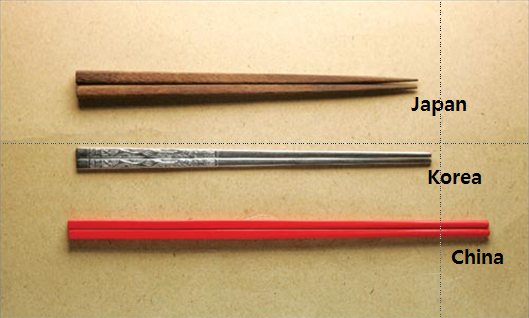Korea is the only country in the world to use metal chopsticks. Other Asian countries, including China, Japan, Thailand, and Indonesia, use chopsticks made of wood, or bamboo. Not only are Korean chopsticks made of metal, but they’re also flatter, square in shape, and often more of a ‘middle length’ than the chopsticks you’d find elsewhere.

‘Chopstick’ in Korean is 젓가락, or ‘Cheot-garak’, with ‘cheo’ meaning ‘chopsticks’, and ‘garak’ meaning ‘sticks’. A typical Korean meal is eaten with a pair of metal chopsticks and a large metal spoon, with the chopsticks always laid on the table on the right-hand side. To make food easier to pick up using chopsticks, you might find many restaurants of families have intentionally scuffed and scratched the chopstick’s pointiest end to make it rougher. Often, the flat ends are ornately decorated with traditional Korean carvings, such as that of a heron.
Metal chopsticks nowadays are usually made from steel. In bygone eras, chopsticks used by affluent families, or on special occasions, were made from gold, silver, or brass. If you’re ever given a pair of chopsticks made from a precious metal when eating at a Korean household, know that you are seen as a very special guest!
But why did Korea develop the tradition of using metal chopsticks? One major theory is that royalty during the Baekje period began using silver chopsticks as a way of protecting themselves from being poisoned by their enemies, as the silver would change color when in contact with a poisonous chemical. It is said that the common people then began to use steel chopsticks themselves, as a way of emulating the King.
Other theories state that, because Koreans used a spoon to eat their rice (unlike other Asian countries) it was not necessary to use stickier, wooden chopsticks. It is generally believed in Korea that metal chopsticks are more hygienic than wooden ones, too.
In the afternoons, traditional Korean restaurants will have a ‘break time’ between lunch and dinner, during which used chopsticks are placed into large bowl of boiling water to sterilize them. After sterilization, the metal chopsticks are placed back into individual paper slips or chopstick holders. These days, many restaurants store chopsticks in an electric sterilization unit.
Although chopsticks made of metal mean they are heavier, and sometimes more difficult to get to grips with, they’re easier to clean, and much better for the environment than disposable varieties!
They also come in very handy a few bottles of Soju down the line, when they may double up as percussion instruments 🙂
Gastro Tour Seoul’s CEO Veronica Kang’s original blog was even called ‘Heavy Metal Chopstick’ – a hat-tip to Korea’s unique tradition! Korean speakers can check out her blog, now called ‘편식주의자’ (or ‘Foodie Ideologist’), here.
